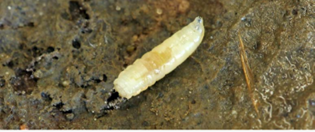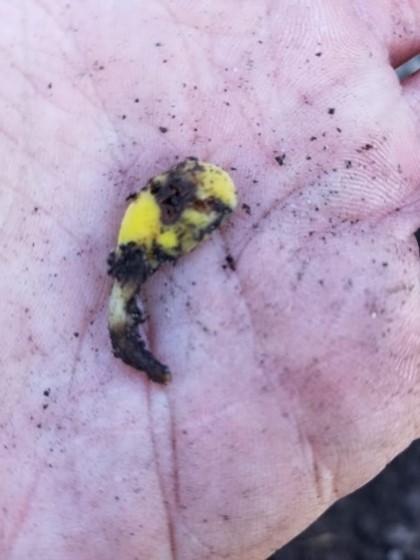The Seedcorn Maggot, also known by its Latin name Delia Platura, is the most common root maggot pest found in Quebec’s soybean fields. As seeding time approaches, you need to be aware of its presence and what it can do to your crops. Read this article to learn more!
Life cycle
To begin, the Seedcorn Maggot produces an average of 2 to 4 generations every year. It is hard to know the exact number of generations because of their asynchronous emergence. Seedcorn Maggots can be observed in different development stages simultaneously in fields.
After overwintering underground in the form of pupae, the first generation of adult flies appears in the spring. They emerge when the soil is wet and outdoor temperatures are neither too warm nor too cold (min 3.9°C and max 33°C).
The females lay their eggs close to the plants, in wet soils that are rich in organic matter. Each female lays more than 100 eggs per year in total, singly or ten at a time. The eggs hatch in about two days, when the temperature is between 20° and 25°C.
The larvae undergo three growth stages over the course of 1 to 4 weeks, during which time they feed on germinating soybeans. Then they return to the soil, burrowing down 7 to 13 cm, where they transform into pupae, either to hibernate or make way for the next generation.
Identification
Eggs: The eggs are white, elongated, and oval shaped. They measure 1 mm long by 0.3 mm wide.
Larvae: The legless larvae are a translucent yellowish white. They have black hook-like mouthparts at the head end and tubercles at the abdominal end. The larvae range in size from 0.7 mm to 7 mm at maturity.

@Cérom
Pupae: The Pupas are brown, oval shaped and measure 4 to 5 mm long by 1.5 mm wide.
Adults: The adult fly is grayish brown with reddish eyes and a striped thorax. It measures between 4 and 7 mm.
Damage
The first two generations of Seedcorn Maggots are the ones that cause the most damage to soybean crops. The larvae tunnel into germinating seeds to feed. They munch on the plants’ cotyledons, and damage stems and roots.

Prevention
Changes in seeding and fertilizing techniques, and other large crop systems may be necessary to diminish its impact. Here are a few tips:
- Delay incorporating green manure and organic materials into the soil until after planting;
- Plant seeds when the soil is warm enough to allow rapid seed germination;
- Increase the seeding rate to prevent losses;
- Seeds may be treated with Fortenza as a last resort.
Vigilance is key during this insect control period. Have any questions? Contact your Prograin representative.
Sources:
CRAAQ. (2023). Fiche technique, Mouche des semis. IRISS phytoprotection. https://www.iriisphytoprotection.qc.ca/Fiche/Insecte?imageId=7684
Boquel et all. (2018, 5 juin). Grandes cultures, Fiche technique : Mouche des semis. Agri-Réseau. Document_97792.pdf (agrireseau.net)
Syngenta. (2023). Fortenza seed treatment for soybeans. Syngenta Canada. Fortenza – Seed Treatment | Syngenta CA
